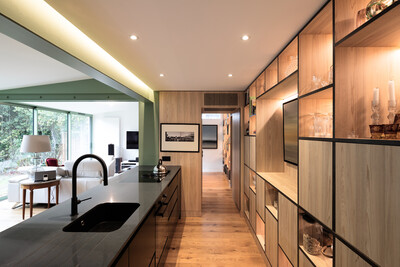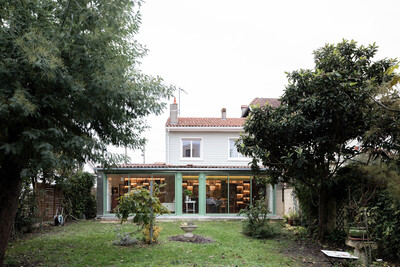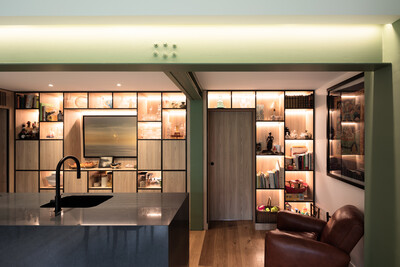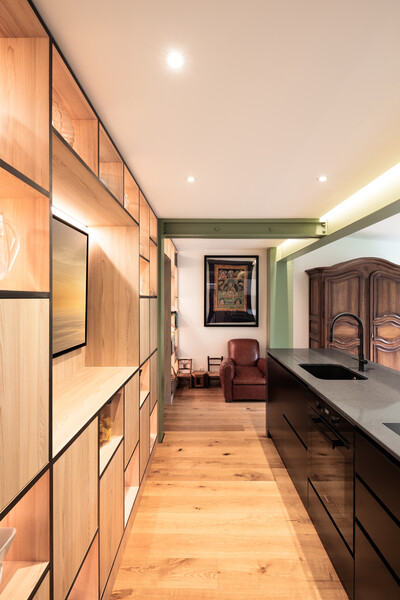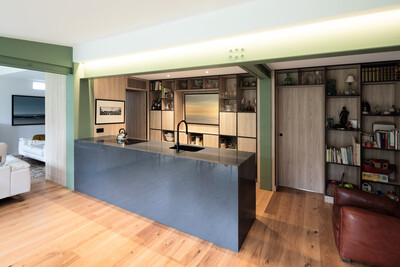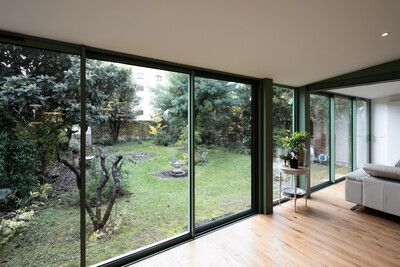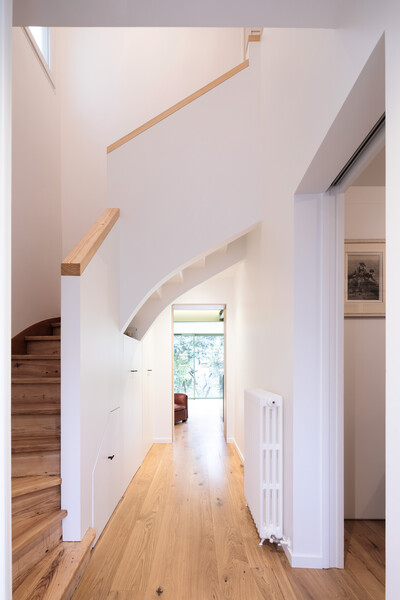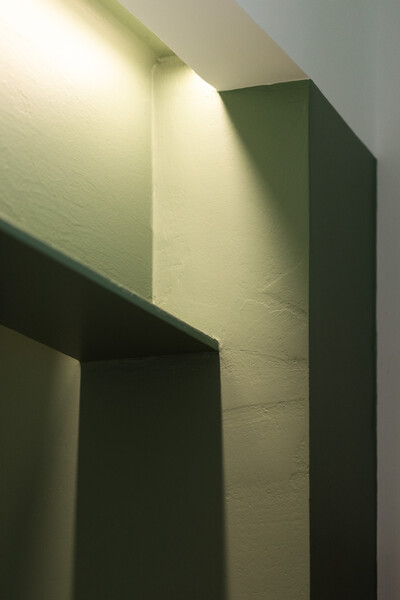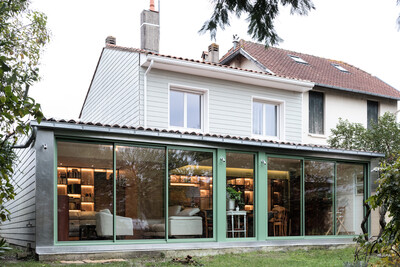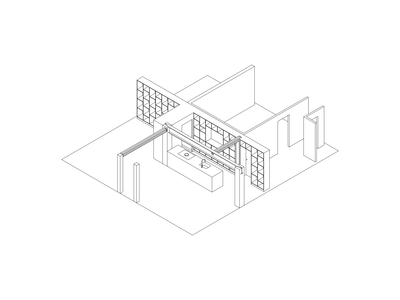A metal structure to recompose the interior spaces of a residence, accompanied by custom-built furniture that is versatile and fit for purpose.
Home renovation
A couple of young retirees left their apartment in the downtown area to move into a house with a garden in a residential neighbourhood of Bordeaux. The new owners wanted to metamorphose the ground floor, de-compartmentalising it and opening it up to the exterior. The lower part of the house would be their living area. Upstairs, occasionally occupied by family and friends, would be left as it was. The openings made in the bearing points and the metal structure section off the space of a new area comprising kitchen, lounge, and dining room. The modifications to the existing structure are painted green, echoing the lush garden and the exterior weatherboarding. The arrangement of the custom furniture connects the various functions, progressively shifting from one use to another. The storage in the kitchen becomes bookshelves. In the bedroom, the access to the bathroom is through one of the closet doors.
171 rue du Tondu 33 000 Bordeaux — France
09 81 24 04 40
Stanislas Elluin
Architect DEHMONP, partner
stanislas.elluin@edgar.archi
Igor Duolé
Architect DEHMONP, Civil Engineer ESTP, partner
igor.duole@edgar.archi
Ludovic Esnault Gillon
Architect DE, partner
ludovic.gillon@edgar.archi
Caroline Chabot
Architect DE
caroline.chabot@edgar.archi
Emeric Le Bos
Architect DE
emeric.lebos@edgar.archi
Vincent Saura
Architect DEHMONP
vincent.saura@edgar.archi
Design: Spassky Fischer and Antoine Elsensohn
Photography: Ivan Mathie
Texts: Fanny Léglise
Development: Tristan Bagot
Edgar sees contemporary architecture as a way of generously exploring both spatial and social potential. Each project represents a chance to question and test various possibilities so as to spark a conversation with the customer. Edgar pays particular attention to the historical and landscaping context that each situation presents. Each experience requires flexibility in terms of process on the part of its designers and their solutions. Oscillating between devising a home extension on a shoestring and an extraordinary commission requires major adjustments, in which the eclecticism of architectural composition becomes clear. Edgar seeks a sensitive sobriety that stems from the enhancement of structure. The constructive aspect is expressed through grid compositions that organise the space. The architecture is explicit, avoiding overstatement. The finishings are discreet, with the accent placed on constructive efficacy.
The structure forms the architecture,
the material defines the project,
and story is its guide.
The Edgar office is on a street corner, engaging local practice, and handy to its partners. Added to the complementary abilities of its founders (engineering, architecture, scenography, and architectural culture communication) were the singular profiles of a rapidly expanded team. Given how scales and fields of intervention are freely invested, the duos established to manage each project are mixed and matched. The power of collective work guarantees an open-minded vision of the profession, where the agency takes the time to discuss architecture and show its work, particularly behind-the-scenes views of its construction sites.
Born in 2017, Edgar is an alter ego, the acronym of its three founders, graduates from the École Nationale Supérieure d’Architecture et de Paysage de Bordeaux. The agency was created through Stanislas Elluin’s, Igor Duolé’s, and Ludovic Gillon’s shared ideas about architecture. The complementary backgrounds of its founders make up “the album” of Edgar, based on a common analysis of cultures of habitation and design of urban systems, relating architecture to its historical period and composition to its significations.
A metal structure to recompose the interior spaces of a residence, accompanied by custom-built furniture that is versatile and fit for purpose.
Home renovation
A couple of young retirees left their apartment in the downtown area to move into a house with a garden in a residential neighbourhood of Bordeaux. The new owners wanted to metamorphose the ground floor, de-compartmentalising it and opening it up to the exterior. The lower part of the house would be their living area. Upstairs, occasionally occupied by family and friends, would be left as it was. The openings made in the bearing points and the metal structure section off the space of a new area comprising kitchen, lounge, and dining room. The modifications to the existing structure are painted green, echoing the lush garden and the exterior weatherboarding. The arrangement of the custom furniture connects the various functions, progressively shifting from one use to another. The storage in the kitchen becomes bookshelves. In the bedroom, the access to the bathroom is through one of the closet doors.
